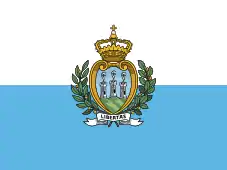Outline of World War I
The following outline is provided as an overview of and topical guide to World War I:
World War I – major war centred in Europe that began on 28 July 1914 and lasted until 11 November 1918. It involved all the world's great powers,[1] which were assembled in two opposing alliances: the Allies (centred on the Triple Entente of Britain, France and Russia) and the Central Powers (originally centred on the Triple Alliance of Germany, Austria-Hungary and Italy).[2] More than 70 million military personnel, including 60 million Europeans, were mobilised in one of the largest wars in history.[3][4] More than 9 million combatants were killed, largely because of great technological advances in firepower without corresponding advances in mobility. It was the sixth deadliest conflict in world history, subsequently paving the way for various political changes such as revolutions in the nations involved.[5]
Nature of World War I
World War I can be described as all of the following:
World War I was further characterized by the following types of warfare:
Causes of World War I
Long term influences leading to World War I
- Imperialism
- Militarism
- Nationalism
- Russia and Siberia
- Destabilizing European balance of power
- Franco–Prussian War (1870–1871) – brought the establishment of a powerful and dynamic Germany, causing what was seen as a displacement or unbalancing of power
- Balkanization
- Tensions between Austria and Serbia
- May Overthrow
- Pig War
- Bosnian crisis
- Tensions between France and Germany
- Tensions between Russia and Austria
- Tensions between the United Kingdom and Germany
- Tensions between Italy and Austria
- Web of alliances
- Diplomatic history of World War I
- Triple Entente
- Triple Alliance (1882)
- Treaty of London, 1839, about the neutrality of Belgium
- Dual Alliance
- German-Austrian treaty (1879) or
- Franco-Russian Alliance (1894)
- Entente Cordiale between France and the British
- Anglo-Russian Entente of 1907
- German Imperial War Council of 8 December 1912
- Cult of the offensive – Considerations of the advantage of striking first.
Short term influences leading to World War I
- Assassination of Archduke Franz Ferdinand of Austria
- July Crisis
- French entry into World War I
- German entry into World War I
- Japanese entry into World War I
Participants in World War I
World War I was fought between the Allies and the Central Powers.
The Central Powers (Triple Alliance (1882))
The Allies (Triple Entente)
Main Allied countries
 French Third Republic (including French colonial forces)
French Third Republic (including French colonial forces) Russian Empire (until March 1917),
Russian Empire (until March 1917),  Russian Republic (until November 1917)
Russian Republic (until November 1917).svg.png.webp) Kingdom of Serbia
Kingdom of Serbia British Empire and Great Britain
British Empire and Great Britain.svg.png.webp) Canada
Canada_crowned.svg.png.webp) Kingdom of Italy (April 1915 and after) (including Italian colonial forces)
Kingdom of Italy (April 1915 and after) (including Italian colonial forces) Kingdom of Belgium (including Belgian colonial forces)
Kingdom of Belgium (including Belgian colonial forces).svg.png.webp) United States of America, American entry into World War I (1917 and after)
United States of America, American entry into World War I (1917 and after)
Other military allies
Other states that had military participation:
.svg.png.webp) Kingdom of Montenegro
Kingdom of Montenegro.svg.png.webp) Empire of Japan
Empire of Japan Portuguese Republic (March 1916 and after) (including Portuguese colonial forces)
Portuguese Republic (March 1916 and after) (including Portuguese colonial forces) Kingdom of Romania (August 1916 – May 1918)
Kingdom of Romania (August 1916 – May 1918).svg.png.webp) Kingdom of Greece (November 1916 for the Government of National Defence; June 1917 for the whole country)
Kingdom of Greece (November 1916 for the Government of National Defence; June 1917 for the whole country).svg.png.webp) Albania
Albania.svg.png.webp) Brazil (October 1917 and after)
Brazil (October 1917 and after).svg.png.webp) Armenia (May 1918 and after)
Armenia (May 1918 and after) Czechoslovakia – See Czechoslovak Legions
Czechoslovakia – See Czechoslovak Legions Finland (October 1918 and after)
Finland (October 1918 and after) Nepal (soldiers served under the British Indian Army)
Nepal (soldiers served under the British Indian Army) Kingdom of Siam
Kingdom of Siam San Marino (June 1915 and after)
San Marino (June 1915 and after)
Nominal Allies
States that declared war, but had no military involvement:
 Andorra
Andorra Bolivia (April 1917 and after)
Bolivia (April 1917 and after).svg.png.webp) China (August 1917 and after)
China (August 1917 and after).svg.png.webp) Costa Rica (May 1918 and after)
Costa Rica (May 1918 and after) Cuba (April 1917 and after)
Cuba (April 1917 and after) Ecuador (December 1917 and after)
Ecuador (December 1917 and after) Guatemala (April 1918 and after)
Guatemala (April 1918 and after) Liberia (August 1917 and after)
Liberia (August 1917 and after).svg.png.webp) Haiti (July 1918 and after)
Haiti (July 1918 and after) Honduras (July 1918 and after)
Honduras (July 1918 and after) Nicaragua (May 1918 and after)
Nicaragua (May 1918 and after) Panama (December 1917 and after)
Panama (December 1917 and after).svg.png.webp) Peru (October 1917 and after)
Peru (October 1917 and after) Uruguay (October 1917 and after)
Uruguay (October 1917 and after)
Conduct of the war
- Allied declarations of war
- British propaganda during World War I
- Convoys in World War I
- German occupation of Luxembourg in World War I
- Roosevelt's World War I volunteers
- Strategic bombing during World War I
- World War I conscription in Australia
- World War I naval arms race
- United States Navy operations during World War I
- Military engagements of World War I
World War I by region
World War I theatres, fronts, and campaigns
- Western Front (World War I)
- Eastern Front (World War I)
- West Africa Campaign (World War I)
- East African Campaign (World War I)
- Italian Campaign (World War I)
- Sinai and Palestine Campaign
- Caucasus Campaign
- Mesopotamian Campaign
- Gallipoli Campaign
- Attacks on North America during World War I
Naval campaigns of World War I
Central Powers
- Austria-Hungary during World War I
- Bulgaria during World War I
- Germany during World War I
- Ottoman Empire during World War I
- Aliyah and yishuv during World War I
- Armenia in World War I
- Seyfo
- Greek genocide
- Deportations of Kurds (1916–1934)
- Prosecution of Ottoman war criminals
Main allies
- Bulgaria during World War I
- Serbia during World War I
- France during World War I
- Russia during World War I – food shortages in the major urban centres, and poor morale due to lost battles and heavy losses sustained, brought about civil unrest which led to the February Revolution, the abdication of the Tsar, and the end of the Russian Empire.
- Russian Revolution (1917) – end of Imperial Russia
- February Revolution –
- October Revolution – beginning of the Soviet Union
- Poland during World War I
- Finland during World War I
- Ukraine during World War I
- Russian Revolution (1917) – end of Imperial Russia
- British Empire during World War I
- Italy in World War I
- United States in World War I
Other allies
Nominal allies
- Andorra during World War I
- Bolivia during World War I
- China during World War I
- Costa Rica during World War I
- Cuba during World War I
- Ecuador during World War I
- Guatemala during World War I
- Liberia during World War I
- Haiti during World War I
- Honduras during World War I
- Panama during World War I
- Peru during World War I
- Uruguay during World War I
World War I impact on neutral countries
- Norway in World War I
- Mexico in World War I
- Ireland and World War I
- Montserrat in World War I
- Spain in World War I
- Switzerland during the World Wars
- Vietnam during World War I
- Afghanistan Afghanistan – received a German diplomatic mission trying to convince it to act against the British in India
- Argentina – Ally to US by treaty (see ABC countries for more information)
- Bhutan
- Chile – Ally to US by treaty (see ABC countries for more information)
- Colombia
- Denmark – Traded with both sides.
- El Salvador
- Ethiopian Empire – received a German diplomatic mission trying to convince it to act against the British in Africa
- Liechtenstein – Had a customs and monetary union with Austria-Hungary.
- Luxembourg – Never declared war on the Central Powers despite being invaded and occupied by Germany.
- Mongolia -
- Mexico- Declined an alliance with Germany (see Zimmermann Telegram). An ally to the United States by treaty (see ABC countries).
- Netherlands Netherlands – An ally of the United Kingdom by treaty. Traded with both sides.
- Norway – Gave naval assistance to the United Kingdom.
- Paraguay
- Persia – Occupied by British and Russian troops.
- Spain Spain – Also treaty bound ally to the United Kingdom.
- Sweden during World War I – Financially supported Germany.
- Switzerland – Switzerland did declare a "state of siege".
- Venezuela – Supplied the Allies with oil.
People in World War I
Leaders in World War I
Military forces of World War I
- Category:World War I flying aces
- List of World War I flying aces
- List of British armies in World War I
- List of British corps in World War I
- List of British divisions in World War I
- List of Indian divisions in World War I
- Austro-Hungarian Armed Forces
- German Army (German Empire)
- Royal Serbian Army
Technology during World War I
Vehicles of World War I
Weapons of World War I
Common military awards
United States
British Empire
France and Belgium
Imperial Germany
- Iron Cross
- Pour le Mérite also known as the "Blue Max"
- House Order of Hohenzollern
- Order of the Red Eagle
Kingdom of Serbia
Austria-Hungary
The End of World War I
- Armistice of Mudros (October 30, 1918) – surrender of the Ottoman Empire
- Armistice of Villa Giusti (November 3, 1918) – surrender of Austria-Hungary
- Armistice with Germany (November 11, 1918) – surrender of Germany
Aftermath of World War I
- World War I reparations
- Dissolution of the Austro-Hungarian Empire into several successor states:
- Cession by Austria-Hungary of Transylvania and Bukovina to Romania.
- Cession by Austria-Hungary of the southern half of the County of Tyrol and Trieste to Italy
- Establishment of the First Republic of Armenia
- Further Balkanization
- World War II
World War I-related media
- List of books about World War I
- List of World War I films
- World War I in literature
- World War I in popular culture
Non-fiction
Fiction
World War I remembered
See also
References
- Willmott 2003, pp. 10–11
- Willmott 2003, p. 15
- Keegan 1988, p. 8
- Bade & Brown 2003, pp. 167–168
- Willmott 2003, p. 307
Further reading
- Bond, Brian. "The First World War" in C. L. Mowat, ed. The New Cambridge Modern History: Vol. XII: The Shifting Balance of World Forces 1898-1945 (2nd ed. 1968) online pp 171–208.
External links
- The War to End All Wars on BBC
- WWI Service Questionnaires at Gettysburg College
- A multimedia history of World War I
- The Heritage of the Great War, Netherlands
- Collection of World War I Color Photographs
- The Commonwealth War Graves Commission
- Royal Engineers Museum Royal Engineers and the First World War
- World War I : Soldiers Remembered Presented by the Washington State Library and Washington State Archives
- The World War I Document Archive Wiki